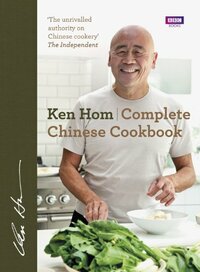Take a photo of a barcode or cover
“I remember when traveling in China in the early 1980s how disappointed I was at the general level of cooking and how I lamented the lack of attention to quality.” I think that is where this book shines. Ken Hom is trying to call our attention, not just to Chinese food, but QUALITY Chinese food.
The introductory chapters provide a brief description and distinction between Southern (Cantonese), Northern, Eastern and Western (Szichuan, Hunan) cooking styles and traditions, and the new modern Chinese cooking. A brief intro is given to the basic ingredients not normally found on American pantry shelves, along with tips on how to find the best flavor in some of them (i.e. whole bamboo shoots instead of pre-cut). The descriptions of noodles and rice with differences and instructions is helpful to a beginner who does not know the difference between Egg noodles, wheat noodles and rice noodles. Hom also covers unique-to-Chinese (or Asian) cooking wares and cutting techniques.
One nit: He says he no longer eats shark’s fin for sharks are being killed and endangered for their fins. Yet, it is okay to cook bird’s nest, when the nesting birds and the next generation of the birds are put in jeopardy. If you are not aware, check out videos of what it takes to gather the nests; it also puts the human gatherer in life-threatening jeopardy trying to use ladders in slimy, uneven, rocky footing to gather nests from the ceilings of caves, all so some rich person can have a rare ‘delicacy’. Might as well add rhino horns to the soup, too.
After the intro chapters, the book follows familiar format of covering appetizers, soups, meat, poultry, etc. The recipes provide the standard format of an introduction to the dish (often the traditional locale and other trivia), a list of ingredients, and then detailed instructions to completing the recipe. Often the list of ingredients has measurements in both English (ounces oz., tablespoons tbsp teaspoons tsp.) and metric scales (ml). It is here that you will find what you do or do not have on your pantry shelf.
One thing I do not like about this book is that, frequently, no pictures are shown of the finished dishes. A whole page picture of caramelized walnuts, but no picture of steamed spare ribs with black bean sauce, or tiny pictures of Hom’s arm pouring rice wine into a recipe. I realize that Hom is a famous chef, and it is what might be selling the book, but after the cover and the intro, I would prefer to see the finished dishes rather than Hom prepping vegetables or cooking food.
The introductory chapters provide a brief description and distinction between Southern (Cantonese), Northern, Eastern and Western (Szichuan, Hunan) cooking styles and traditions, and the new modern Chinese cooking. A brief intro is given to the basic ingredients not normally found on American pantry shelves, along with tips on how to find the best flavor in some of them (i.e. whole bamboo shoots instead of pre-cut). The descriptions of noodles and rice with differences and instructions is helpful to a beginner who does not know the difference between Egg noodles, wheat noodles and rice noodles. Hom also covers unique-to-Chinese (or Asian) cooking wares and cutting techniques.
One nit: He says he no longer eats shark’s fin for sharks are being killed and endangered for their fins. Yet, it is okay to cook bird’s nest, when the nesting birds and the next generation of the birds are put in jeopardy. If you are not aware, check out videos of what it takes to gather the nests; it also puts the human gatherer in life-threatening jeopardy trying to use ladders in slimy, uneven, rocky footing to gather nests from the ceilings of caves, all so some rich person can have a rare ‘delicacy’. Might as well add rhino horns to the soup, too.
After the intro chapters, the book follows familiar format of covering appetizers, soups, meat, poultry, etc. The recipes provide the standard format of an introduction to the dish (often the traditional locale and other trivia), a list of ingredients, and then detailed instructions to completing the recipe. Often the list of ingredients has measurements in both English (ounces oz., tablespoons tbsp teaspoons tsp.) and metric scales (ml). It is here that you will find what you do or do not have on your pantry shelf.
One thing I do not like about this book is that, frequently, no pictures are shown of the finished dishes. A whole page picture of caramelized walnuts, but no picture of steamed spare ribs with black bean sauce, or tiny pictures of Hom’s arm pouring rice wine into a recipe. I realize that Hom is a famous chef, and it is what might be selling the book, but after the cover and the intro, I would prefer to see the finished dishes rather than Hom prepping vegetables or cooking food.
A very well put together Chinese cookbook. I specially liked the orientation to sauces and flavorings. Highly recommended.
